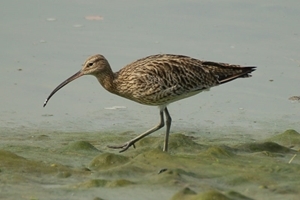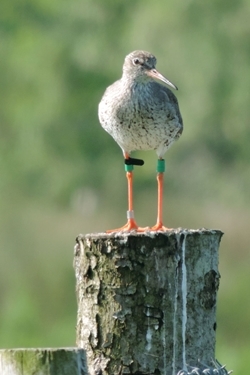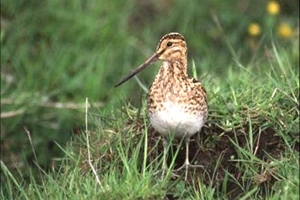The GWCT carries out research on a number of shorebirds and waders. From studies of the migration routes of snipe, lapwing and curlew, to the monitoring of nesting habits of lapwing in wet meadows and arable fields, to developing new techniques to protect them from predators.
Our Gravelly Shores Project has helped create a safer haven for beach-nesting birds on the North Solent National Nature Reserve in Hampshire, where we have transformed a 1.7ha area of scrub-grassland into an open expanse of coastal vegetated shingle and this tailor-made ‘hotel for birds’ thanks to two years of funding through Natural England’s excellent Species Recovery Programme.
The shorebirds covered by various GWCT research and monitoring programmes:
Curlew
 The curlew is the largest shorebird breeding in the British Isles, sometimes tipping the scales at up to 1kg. They breed in a variety of habitats from heather moorland and bogs to arable farmland, and lay up to four large eggs in a nest cup on the ground. Despite their size, nesting curlews are vulnerable to losing their eggs to predators like foxes, crows, badgers, stock animals or even deer. Their chicks are precocial, meaning they are mobile soon after hatching, and they forage for themselves.
The curlew is the largest shorebird breeding in the British Isles, sometimes tipping the scales at up to 1kg. They breed in a variety of habitats from heather moorland and bogs to arable farmland, and lay up to four large eggs in a nest cup on the ground. Despite their size, nesting curlews are vulnerable to losing their eggs to predators like foxes, crows, badgers, stock animals or even deer. Their chicks are precocial, meaning they are mobile soon after hatching, and they forage for themselves.
GWCT scientists have undertaken extensive research to understand curlew nest predators, using trail cameras and predator culling records; habitat selection for nesting and its influence on nest survival; and the factors influencing chick survival. A large sample of GPS-tagged adults has informed understanding of movements of breeding curlew.
Oystercatcher
 Oystercatchers are long-lived waders with the BTO survival record of a ringed bird sitting at 41 years. They are known for sometimes nesting in pretty unusual places, such as the middle of a gravelled roundabout on a busy road, the roof of an MOT centre, and the side of motorways. More commonly, they nest on shorelines, marsh or inland pastures, particularly in the north of Britain. As with curlew, nest predation is a huge problem for oystercatchers, with species such as crows, lesser black-backed gulls and foxes recorded taking eggs. Oystercatchers are one of the few wader species which provision their chicks, although these chicks still face many threats before fledging.
Oystercatchers are long-lived waders with the BTO survival record of a ringed bird sitting at 41 years. They are known for sometimes nesting in pretty unusual places, such as the middle of a gravelled roundabout on a busy road, the roof of an MOT centre, and the side of motorways. More commonly, they nest on shorelines, marsh or inland pastures, particularly in the north of Britain. As with curlew, nest predation is a huge problem for oystercatchers, with species such as crows, lesser black-backed gulls and foxes recorded taking eggs. Oystercatchers are one of the few wader species which provision their chicks, although these chicks still face many threats before fledging.
Current GWCT research has focused on the population of oystercatchers breeding on the Solent coast, with the provision of new shingle nesting habitat, trials of nest cages and raised platforms, alongside detailed study of the factors limiting their breeding success.
Ringed plover
 One of the smallest waders in the UK with a weight range of just 54-82g, ringed plovers usually nest along beaches, making a nest cup lined with tiny stones in the shingle. Inland they sometimes nest in quiet gravelled places like river banks or disused gravel pits. Coastal-nesting ringed plovers face a number of challenges when they are breeding, including disturbance and trampling by humans, predation by a wide suite of predators, and flooding if the tide rises higher than the strandline.
One of the smallest waders in the UK with a weight range of just 54-82g, ringed plovers usually nest along beaches, making a nest cup lined with tiny stones in the shingle. Inland they sometimes nest in quiet gravelled places like river banks or disused gravel pits. Coastal-nesting ringed plovers face a number of challenges when they are breeding, including disturbance and trampling by humans, predation by a wide suite of predators, and flooding if the tide rises higher than the strandline.
Our project work has encompassed extensive colour-ringing to understand recruitment and survival, nest cage trials, a new shingle habitat for nesting, and extensive trail camera monitoring to understand predation pressures.
Lapwing
 Recognised by its glossy dark green plumage (which can appear black from a distance) and its noisy, tumbling display flights in spring, lapwing is widely distributed in lowland Britain and found in many coastal wetlands areas where birds feed on mudflats at low tide.
Recognised by its glossy dark green plumage (which can appear black from a distance) and its noisy, tumbling display flights in spring, lapwing is widely distributed in lowland Britain and found in many coastal wetlands areas where birds feed on mudflats at low tide.
The UK breeding population of the northern lapwing (Vanellus vanellus) has declined by 48% over the past 25 years. This iconic farmland bird is now on the ‘Red List of Birds of Conservation Concern’ in the UK and classed as ‘Vulnerable’ in Europe.
It is estimated that 39% of breeding lapwings in England and Wales nest on arable land and fallow plots created by farmers. One of our studies has involved surveying fallow plots to find out if larger numbers of lapwing chicks can survive on farmland fallow plots if provided with more space to hide from predators and increased levels of invertebrates to feed on.
Redshank
 As the name suggests, redshank is a wading bird with distinctive red legs (‘shanks’). It is both a native breeder and winter visitor from Iceland and Scandinavia.
As the name suggests, redshank is a wading bird with distinctive red legs (‘shanks’). It is both a native breeder and winter visitor from Iceland and Scandinavia.
Redshank pairs mainly nest in lowland wet grassland and salt march habitats. They are particularly noisy when setting up territories and while rearing chicks, but can go very quiet while incubating eggs.
Once the chicks have hatched, they forage for themselves straight away, with parents only directing them to good food sources and protecting them from predators. Redshank chicks are extremely good at hiding and camouflaging themselves in vegetation.
Redshank was once widespread across the UK, but BTO monitoring shows their distribution is becoming increasingly fragmented as numbers have fallen rapidly in response to changing agricultural practices.
As a ground-nesting bird, they are vulnerable to predators, but their cryptic nesting strategy – nests are well hidden within vegetation and the chicks are very good at hiding – offers some protection in optimal habitat. They can also benefit from predator management and temporary electric fencing of key nesting areas.
Snipe
 Elusive and mysterious, the snipe is a master of disguise. When danger approaches, it does not flee, but instead melts into the landscape, perfectly camouflaged. This remarkable ability makes spotting them a rare privilege – and means we know surprisingly little about their lives.
Elusive and mysterious, the snipe is a master of disguise. When danger approaches, it does not flee, but instead melts into the landscape, perfectly camouflaged. This remarkable ability makes spotting them a rare privilege – and means we know surprisingly little about their lives.
We do know that numbers of common snipe have declined across the UK, placing it on the Amber conservation list. Changes in land use, drainage of wet meadows, and shifts in insect populations have all played a part. Snipe live in wet grassland, marshes and on moorland where it nests in simple scrapes and uses its long, probing bill to find insects, earthworms and crustaceans in the mud.
In winter, the British Isles hosts snipe from across Europe – from local breeders to long-distance migrants from Russia, Iceland and the Faroes. In a new project, which began this year, our researchers are fitting these adult visiting snipe with GPS tags to map out their migration routes back to their summer breeding sites. We believe the data this reveals could be key to future population modelling and conservation efforts.